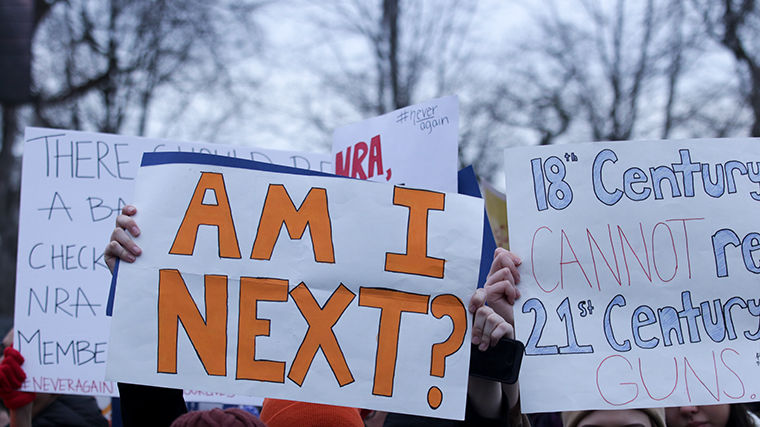March For Our Lives — 85,000 assemble in Union Park
April 2, 2018
At only five years old, Eduardo Medel began to notice gun violence in his South Side community. While he remembers how Fourth of July filled the night sky with bright lights, he also recalls abrupt flashing gunshots on his street corner, Medel—now 18—told the crowd of approximately 85,000 at Union Park.
The sounds of gunshots became police sirens and the thuds of collapsing dead bodies. Those sounds echoed in his eardrums and would keep him awake until his mind forced him to sleep after becoming accustomed to these violent nights, he said.
Medel is now a representative of Young Urban Progressives and a senior at Jones College Prep, 700 S. State St. He was one in a series of speakers at the March 24 March For Our Lives Chicago rally at the West Town park where march organizers and advocates called on lawmakers to act on gun violence and for Chicagoans to vote out those who fail to do so.
More than a million people frustrated by continuous mass shootings and a lack of action from the federal government took part in the marches in various cities throughout the nation.
Tammy Stams, a stay-at-home mother from Lincoln Square, said she came to the rally to support her 17-year-old son, Eli, who participated in the march. It is incumbent upon older generations to encourage young people to advocate for stricter gun regulation because “we couldn’t get it done, so it’s our job to support them,” she said.
Her husband, Bob Walsh, a land surveyor, said he is sick of the continuous nationwide gun violence.
Both Walsh and Stams said they become consumed with anger whenever politicians say it is not the time to discuss gun regulation but instead offer “thoughts and prayers” after a mass shooting. They said politicians are more interested in not antagonizing the gun lobby than on acting on their constituents’ wishes.
“It’s hard to believe it’s anything more than a desire to protect their positions,” Stams said. “It doesn’t seem like the greater people feel as though guns are more important. I don’t think most people feel as though a Second Amendment right is any more important than a First Amendment right, or a right to live and exist without fear.”
Politicians are unable to empathize with victims or their friends and families because they do not live in neighborhoods plagued with gun violence, Walsh said. They simply toss aside citizens pleas for help, he added.
While gun regulation critics cite the Second Amendment, Walsh said “life, liberty and the pursuit of happiness” is also in the Constitution, and all amendments should support those goals.
Money from gun lobbyists, particularly from the NRA, is the greatest barrier to creating stronger national gun regulations, Jeremy Liskar, one of the march organizers and a senior at Whitney M. Young Magnet High School, 211 S. Laflin St., told The Chronicle after the march. Politicians who support gun regulation reform are scared of blowback from donors, he added.
The large number of participants in the march was encouraging and shows that poll numbers do not lie, and people are in favor of common sense gun regulation, Liskar said. The march turned out better than expected and was also unique compared to the others nationwide, he added.
“In Chicago, we march for our lives every single day,” Liskar said. “We were able to give a platform to the black and brown communities that are primarily affected by gun violence in Chicago.”
Speakers were able to call for more community and educational resources to reduce gun violence, which is the core of the issue, Liskar said. While Chicago is often used as an example by gun regulation critics, they misinterpret the city’s environment, he added.
Sixty percent of illegally possessed firearms confiscated by the Chicago Police Department between 2013–2016 came from surrounding states with looser gun regulation, according to a 2017 Gun Trace Report, as reported Nov. 6, 2017, by The Chronicle.
The Feb. 14 shooting in Parkland, Florida, has triggered a powerful wave of student activism for gun reform and has generated critics who claim young activists are misinformed, a viewpoint that Liskar called obnoxious.
“Young people have been ignored for far too long,” Liskar said. “They’re our representatives too, and we deserve a voice in government.”
Thanks to the media attention and elected officials making public statements about the marches, Liskar said student voices were heard and might soon be taken seriously. However, some Chicago march media coverage lacked an important message, he said.
“While it’s important that [the media] was talking about young people having a voice and getting empowered, we were a little disappointed to see less attention to the communities of color that got the mic at the rally,” Liskar said. “They weren’t covered as much as we’d hoped.”








